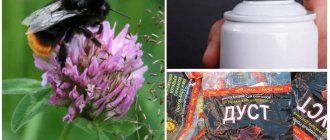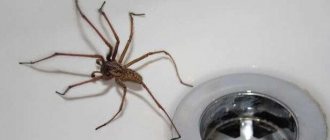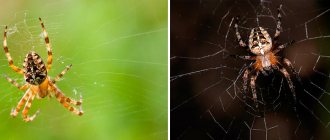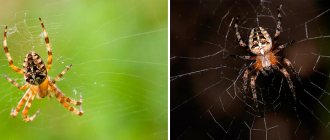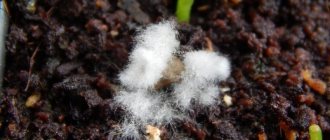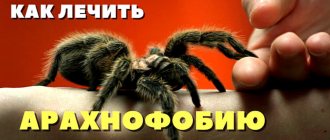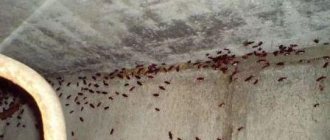For unknown reasons, it is spiders that evoke some irrationally unpleasant feelings in the vast majority of humanity - disgust, fear, disgust. With a high degree of probability, any summer resident, unexpectedly seeing such a “neighbor” on the porch, in the basement or in the room, will try, first of all, to slam him.
Let's try to use logic and figure out what types of spiders there are in our areas, where and why they get into the house, and why you shouldn't kill every spider you meet, even if its appearance doesn't make you very happy.
We will not mention poisonous exotics from the south of Russia like the South Russian tarantula or karakurt; in this material we will make do with listing the most common species of spiders that you can easily see in the middle zone, in the same Moscow region.
Funnel spiders (Agelenidae), house and labyrinth
Funnel spiders: house spider on the left, labyrinth on the right
Representatives of this family are frequent inhabitants of cellars and basements of residential buildings around the world.
The house spider (Tegenaria domestica) is usually tan in color with a "pattern" on the back, its slightly hairy body can be more than a centimeter long, and its darker legs are about twice as long as the body. Females are usually slightly larger, thicker, and shorter-legged than males.
House spiders build their rather large flat webs with a funnel-shaped indentation at one end in dark places. They themselves sit in these very “funnels”, waiting for prey, small insects - moths, flies, cockroaches. When prey gets caught in the net, they quickly rush at it and kill it. These spiders use their web for about two to three weeks, after which they leave it and weave a new one. Outdoors they can live in thick grass, wood cracks, among dry bushes, etc.
These spiders are usually active in the dark, avoid meeting people, but in the most extreme cases they can bite - the bite is practically painless and absolutely not dangerous.
Also in the low-growing dry thickets on the site live “relatives” of the house spider - labyrinth spiders (Agelena labyrinthica) , which are usually a little lighter, but look and behave exactly the same. And they are also not poisonous to humans.
Cooperation technique
There are more than two thousand species of spiders in Russia. In the middle zone alone there are more than 700, these are the most common and very common creatures found at every step (the fact that we don’t notice most of them is rather our problem). In a garden or meadow, one square meter may well contain hundreds of one and a half spiders. This is on average. Arachnophobes should not read this information. There are not enough insects for such a horde, so spiders eat their smaller brothers without remorse.
In view of such gluttony, spiders have no price, so it is worth trying to establish cooperation with them.
A web stretched between the branches of trees, bushes, or blades of grass, if it does not interfere with the passage, is better not to touch: the web will attract a huge number of insects, and it works day and night. There is no need to crush spiders running in the grass with your foot - they do no harm, but have a lot of benefits. And what about our appearance?... Not everyone likes us either.
Constant cultivation of all the soil on the site prevents the settling of hunting spiders patrolling the ground zone. It is advisable to leave some under tinned. A good option is with fenced beds and mowed grass growing between them. Keeping the soil of the orchard under grass will also allow spiders to successfully fight insect pests without unnecessary stress. The lawn is welcome, spiders are comfortable there.
Spiders do not lay claim to our vegetables, fruits and berries, but on the contrary, they guard and protect them; it is better to live in friendship with them. But without extra tenderness, spiders may misunderstand us.
It is better not to touch cobwebs stretched between the branches of trees, bushes, or blades of grass.
Jumping spiders (Salticidae)
Different types of jumping spiders
You have probably also seen these “fluffy” medium-sized and compact spiders with large eyes and powerful legs. They easily climb vertical surfaces, including “inconvenient” ones like glass. They can often be seen near human habitation on stone and brick walls, where they bask in the sun. These spiders are also found in thick grass. The color of these arachnids can be very different - black, light brown, striped, spotted.
Jumping spiders are active daytime hunters; they do not weave webs, but track prey (insects and the smallest vertebrates) and jump at it, often over long distances.
Jumping spiders that live in our latitudes are absolutely safe and not poisonous to humans.
How do tarantulas hunt and what do they eat?
Mizgir is a solitary predator and homebody. Tolerates its own kind only during mating. The distance between tarantula burrows is at least 1 m. They never go far from home.
During the day, the Mizgir sits in a shelter and waits for any insect, caterpillar, slug, mouse, frog to appear nearby - this is its food.
The tarantula prefers not to mess with ground beetles of the Scarite genus - their jaws are more powerful and can cause serious injuries in a fight. However, he easily copes with the mole cricket, and she, in turn, takes revenge on the tarantula by eating its helpless offspring.
There are insects that Mizgir does not eat due to a specific smell or taste, for example:
- ladybugs;
- ants;
- blister beetles;
- bedbugs.
The spider ignores all of the above, and when they get inside the hole, it pushes them out with its paws.
The tarantula senses the approach of the victim to the entrance to the lair using the hairs on its body or determines it by the shadow. When an object appears, the misgir jumps out and attacks it.
Powerful mandibles dig into the victim’s body and release poison mixed with digestive enzymes. If an insect pretends to be dead, then the spider feels it with its front paws until it shows signs of life.
At night, the South Russian tarantula becomes more active and leaves the hole in search of prey, but not far. He always stretches out a thread along which he returns back.
If he had to jump out of the den in a hurry and run a long distance, then finding housing can take quite a long time, even if it is within sight. If a Mizgir is thrown about a meter away from the den, it often begins to build a new hole.
The lifespan of a Mizgir rarely exceeds 2 years, and even less for males. In the warm season, tarantulas actively hunt, and shortly before cold weather they deepen the hole, seal the entrance and go into suspended animation (hibernation).
During cold weather, Mizgiri become lethargic, lose sensitivity, and do not recognize prey . Siberian tarantulas (in recent years, spiders have begun to explore an unusual habitat) die en masse during harsh winters.
Hay-making spiders, or long-legged spiders (Pholcidae)
Harvesting spider
Among these small spiders there are many synanthropic species - that is, they are the ones you can easily find in a person’s home.
They have a pale, naked body several mm long with a constriction stalk at the point of transition from the abdomen to the cephalothorax, and the length of the legs can exceed the body size by 20 times, for which the harvestmen are given the name “long-legged”.
Haymaking spiders are predators; they feed on all sorts of creeping and flying little things, which they catch in their randomly woven webs, where they can hang motionless upside down for hours. You can notice these cobwebs in dark, dry and warm corners of rooms (usually abandoned or rarely visited). Spiders can also settle in the open air - in hollows of trees, under stones and dead wood, etc.
Of course, these little ones are not at all dangerous for humans and, when they meet them, they will first of all try to run away and hide.
Haymaker
In the Arachnida class, in addition to the Spiders order, to which the above-described centipedes belong, there is another separate order, Haymakers. Many people know these arthropods under their childhood nickname “braidtail”. They have the same long legs, but the abdomen is segmented and connected to the cephalothorax by a wide base, and not by a “stalk” like a spider. Mosstails feed on small insects, as well as plant tissues, and are absolutely safe for humans! And the mechanism of independent contraction of severed limbs helps the harvester to distract predators in order to have time to run away and hide.
Features of their web
On the spider's abdomen there are arachnoid warts in the form of small tubercles. The web is the secret of the arachnoid glands, is close in composition to silk, and is very interesting both for its properties and the ways in which it is used by the spiders themselves. The most noticeable and familiar option (hated by housewives) is a fishing net, which can be found in houses, barns, gardens, forests and meadows. It is similar to fishing with nets, with its own characteristics: there are frequent nets, there are “tangles”, there are those with sticky threads, there are funnel-shaped ones.
Certain species of spiders cast a trapping net over insects flying or running past. Some spiders use “fishing rods” - webs with sticky glue at the end, to which an analogue of the moth pheromone is added, that is, they catch with bait. The web entangles especially “violent” or large prey.
But the web is not necessary for hunting: it is used by spiders as insurance against falling when jumping, and as a “glider” when spreading. The web also serves as the interior lining of the burrow, an “incubator” for eggs. In some species, the web plays a significant role in mating behavior: the female spider marks the thread with pheromones, and the males weave a special spermatic mesh to transfer genetic material.
At the same time, different glands on the abdomen produce different threads: for movement, fastening, sticky, for cocoons, for braiding prey.
Producing webs is not easy and requires significant resources, so spiders often eat the “waste” material for recycling.
The web has enviable qualities: high elasticity (it breaks when stretched by 200-400%), internal articulation (you can rotate an object suspended on the web as much as you like without twisting); high tensile strength. In addition, it has bactericidal and hemostatic properties - our ancestors applied spider web to wounds for speedy healing.
It has not yet been possible to create an artificial analogue of the web.
Yellow pouch spider or chirocontid (Cheiracanthium punctorium)
Yellow sac spider
These spiders are quite rare and prefer to live in very dry, hot climates, which is why they are more often found in Asia. However, recently, apparently due to climate change, cases of their detection have become more frequent not only in Eastern, but even in Central and Western Europe, so knowing the “enemy in person” will be useful.
Why enemy? Because meeting him, of course, will not be fatal, but it will cause you trouble. Its bite is not only deep and painful, but can also cause unpleasant symptoms such as nausea, swelling, chills, fever and increased blood pressure. Usually painful symptoms disappear within 24-30 hours, otherwise hospitalization is necessary.
The size of this spider is average, about 1-1.5 cm, it has a yellow-brown or greenish dense body, somewhat pointed towards the rear end, strong legs and powerful chelicerae (oral “biting” appendages).
This spider lives in grassy and bushy thickets and can hide in leaves rolled into tubes. It does not weave a wide web, but attacks victims (insects, ticks, small caterpillars) in a jump. Females that lay eggs in tall grass may aggressively defend their cocoons.
Habitat
The South Russian tarantula prefers a dry climate and soft soil, which it needs to build a burrow. Mizgir is suitable for desert, forest-steppe, steppe, semi-desert. Can be found in gardens and orchards.
An important condition is that there must be moisture nearby underground. That is why Mizgiri minks in desert areas are an indicator of the presence of groundwater. The presence of the tarantula is also indicated by the grass saliva and the burrowing insect of the mole cricket.
Regions of Russia where the South Russian tarantula lives:
- Kursk;
- Saratovskaya;
- Belgorodskaya;
- Astrakhan;
- Orlovskaya;
- Tula;
- Lipetskaya.
Mizgir also lives in the Trans-Baikal and Stavropol Territories, on the territory of Kazakhstan, Bashkortostan, Belarus (mainly near rivers), Central Asia and Ukraine.
Orb-weaving spiders (Araneidae), crossworts and argiopes
Cross spiders
Orb weavers usually live on tall shrubs and trees in forest ecosystems, although they can also be found in populated areas.
These spiders are very diverse in size, body shape and color, so it is quite difficult to create a general description.
Of this family, people are most familiar with crosses - they got their name due to the pattern of their thick abdomen, where, against a darker background, light spots form a figure similar to a cross. The body size of these brown, gray, black arthropods is usually 1-2 cm, and the body covering is waxy.
At the end of summer and autumn, large nets-“wheels” of crosses are visible everywhere - in the forest, in gardens, on hedges, under the roofs of buildings, in the darkened corners of buildings, in the window frames of abandoned houses. The fact is that juveniles begin to build nets in the spring, increasing them month after month. These spiders feed on flying insects and are safe for humans - their possible bite, by medical standards, is no more dangerous than a mosquito bite.
Argiope spiders
Orb weavers also include argiopes - very common spiders in our country, which also weave dense wheel-shaped webs on shrubs and herbaceous plants in sunny, often dry places and sit in their center, waiting for prey. In autumn, argiopes actively disperse through the air with the help of cobwebs.
These are medium-sized spiders, about 1.5 cm in length, and females and males can look different - with a thick black and yellow striped abdomen, with a silver-white notched abdomen, with a narrow beige abdomen... These spiders have long legs , can be plain or striped, often located in pairs at the anterior and posterior ends of the abdomen, so that the spider looks like the letter X.
Argiopes feed on various insects, including large ones; their poison is not dangerous for humans and animals, although the bite can be painful.
Some of the orb weavers are included in the regional Red Data Books of Russia and are protected!
a brief description of
The misgir (what it is in the fauna world) can be briefly described as follows: a large poisonous spider, belonging to the araneomorphic species (“wolf spiders”), which will not attack a person first if it is not disturbed.
Mizgiri are often exterminated for their resemblance to dangerous recluse spiders.
External characteristics of mizgir:
- the body is brown-red, spotted above, almost black below. If the Mizgir has not shed for a long time, then its color on top becomes completely red;
- the whole body and legs are densely covered with hairs - with their help the spider catches vibrations of the earth and air. For example, it recognizes human steps within 10-15 m;
- male size – up to 25 mm, female – up to 30 mm;
- There are 8 eyes located on the cephalothorax, and in such a way that the misgir is provided with a full view: 4 in front, 2 behind them, and 2 more a little further away. The spider distinguishes colors and recognizes silhouettes.
The identification mark of the South Russian Mizgir is a black spot on the cephalothorax, which resembles a skullcap.
Knitting spiders, or tetragnathids (Tetragnathidae)
Knitting spider
These spiders prefer to settle on vegetation in damp meadows and forest edges, often on grass and bush branches along water bodies.
Knitters have an elongated, brown or gray, often shiny body 6-12 mm in length, and long legs are often extended back and forth in pairs, mimicking and visually turning into a “stick”.
Tetragnathids build round trapping nets (both horizontal and vertical), often with a hole in the center or very large rectangular cells, feed on insects (mainly mosquitoes and flies), and do not pose any danger to humans.
Folk signs
Many people do not know, but meeting a spider portends good luck, and under certain circumstances, such a sign indicates the need to reconsider your plans. Attitudes towards signs may vary; it is not recommended to ignore them. Wise ancestors always paid attention to the nuances and little things of life.
Spiders and omens about them have been associated with money and prosperity for centuries.
Important! It is not recommended to take these signs too seriously. It is best to clean up, clear the ceiling of cobwebs, and take the insect outside.
Silver spider or water spider (Argyroneta aquatica)
Silver spider
This is the only European aquatic species of spider, so you will not confuse it with anyone else.
Their body is round, gray or brown, up to 15 mm in length, covered with many velvety hairs. They also differ from other spiders in having long swimming bristles on the hind legs and three claws on the legs of the three hind pairs.
Silverfish are often found in still or slow-moving waters. It feeds on various small animals that become entangled in the threads of its underwater web or which it catches while swimming in the water.
A water spider bites very rarely and only for the purpose of self-defense. A person can be injured accidentally by being pulled out of the water along with fish or aquatic plants. Redness, pain, burning, swelling, and swelling appear at the site of the bite. People prone to allergies, with weak immune systems, and young children may experience a deterioration in their health after a spider bite - weakness, nausea, dizziness, headache, and fever. The condition returns to normal in a few days. To speed up the therapeutic effect, take antihistamines.
In some places, silverfish are included in the regional Red Books of Russia and are protected!
Reproduction
The mating season occurs in autumn. The male, attracting the female, vibrates his body and moves his forepaws. The female expresses readiness by repeating his movements. After mating, the male Mizgir quickly leaves so as not to become prey to the excited female.
After fertilization, she goes into a hole and falls into suspended animation. Tarantula eggs are formed only under the influence of solar heat and light (the female specially warms up her belly by pushing it upward), so the ovipositor period occurs in the spring.
The South Russian tarantula intertwines the laid eggs and wears the resulting cocoon of web until the spiderlings begin to move. Then the female gnaws through the shell and releases the offspring outside (usually about 50 spiderlings).
The young are located on the mother's body in several layers, remaining there until they become stronger. Then the spiders gradually spread throughout the surrounding area.
Crab spiders, or sidewalkers (Thomisidae)
Crab spiders
These representatives of arthropods are distinguished by a very swollen spherical abdomen against the backdrop of thin legs.
The color of their body (up to 10 mm long) can be nondescript white, greenish, beige, or, conversely, very bright - two-color, patterned, striped. The first two pairs of legs of these spiders are usually much longer than the hind ones.
Crab spiders can move sideways, which is why they got their nickname. They do not build trapping nets, but lie in wait for their prey (insects and small spiders), sitting on flowers, on leaves, in litter or on the bark of trees. They are absolutely not dangerous for humans.
Prevention of re-emergence of arthropods
The main condition for preventing the return of once expelled spiders is to maintain cleanliness in the home, leading to the complete absence of insects that serve as food for these predators.
Also, to prevent a recurrence of spider infestation, preventive measures should be taken in the form of:
- periodically spraying the room with aromatic products;
- whitewashing ceilings and walls in utility rooms with lime;
- planting in a peppermint area;
- turning on electronic deterrents with the onset of autumn cold weather.
Important! Aromatic substances repel spiders, but do not destroy them. Typically, these remedies last for a maximum of two weeks. To prolong their effectiveness, they should be renewed periodically.
Growing at home
South Russian tarantulas are rarely found as pets. It is interesting to watch them while hunting and while arranging their home. It won't be possible to tame.
An ordinary aquarium can also become a home for a tarantula, but it must have good ventilation. The length and width of the container should exceed the paw span by approximately 3 times. A cover is also required - the spider can easily jump up to 20 cm, and can also get out into the corners, entwining them with cobwebs.
You need to pour loose material on the bottom:
As an option: on one side of the container - clay and sand in half, on the other - vermiculite and black soil. The thickness of the layer must be at least 40 cm so that the tarantula can dig a full-fledged hole. The poured soil is constantly slightly moistened. You can plant plants and put natural shelters: driftwood or branches. There is a lamp on top (mizgiri like to warm themselves).
